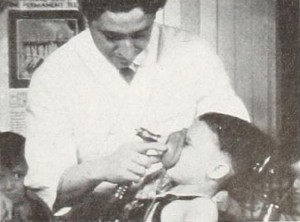
"Morton H. Read has made, in Teeth and Good Health, an effective study of the work accomplished by the Dental Clinic of the Public Schools of Springfield, Mass. This film should be of great interest to educators whose institutions offer a similar service to children of grade school age. The picture lucidly outlines the program followed by the teachers, nurses and doctors in the system set up by this school, to facilitate caring for the children's teeth. Charts and diagrams that warn the children of the danger of neglected teeth are shown, as well as excellent shots of the dentists at work. Thus, through familiarizing youngsters with the importance of dental care and its mechanics, the child is taught not to fear the dentist. A recalcitrant mother serves as a focal point for the detailed explanation of the advantages of the dental program in the school. The filming is marked by competent cinematography, logical sequence arrangement and simplification of detail." Movie Makers, Dec. 1942, 509-510.
"In Thyroidectomy, Henry M. Lester, ACL, has combined all the essentials of the perfect medical film. The delicate color gradations of tissues that mean much to the surgeon are clearly evident, due to excellent exposure, lighting and suitable film stock. Thorough presentation of the operating technique is given by means of suitable telephoto lenses and properly placing the camera in relation to the surgical field. An unusual feature of this particular operation is the large number of instruments which necessarily must remain in the field most of the time, creating a difficult problem for the photographer in that the many shining surfaces tend to produce undesirable reflections. However, Mr. Lester has solved this problem to perfection. The film is a result of the combination of highly specialized skill, equipment designed for the purpose and an exact knowledge of the requirements for the perfect surgical film." Movie Makers, Dec. 1934, 534.
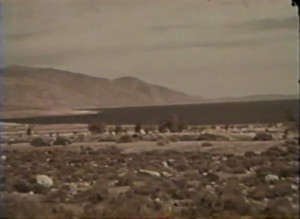
Educational short film showing farming in California, and several mines and ghost towns in Nevada.
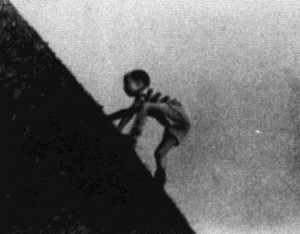
"Does a fine job of demonstrating special effects and tricks, the cameras which can and cannot do them, how they are done and used. Very educational for any prospective filmer." PSA Journal, Nov. 1956, 45.
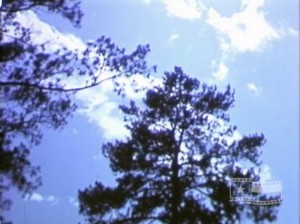
"The Texas Forest Service was faced with a grave problem. Large parts of Texas were being devastated and deforested by numerous fires. The fires were caused by the idle fancy and carelessness of backwoodsmen. Which He Hath Planted was produced for the Service by Larry J. Fisher, ACL, as part of the campaign to lead these woodsmen into more constructive paths. It is a striking example of how, with imagination, a motion picture can be constructed to fit the needs of a very special situation. Mr. Fisher and the Forest Service had to find a common ground on which to base their appeal against the pyromaniacal instinct. Realizing that, however uneducated, most people from the backwoods have both acquaintance with and veneration for the Bible, they decided to peg their entire film on quotations from the Scriptures. What they have produced is a beautiful welding of applicable Biblical passages, both spoken and sung, to forest scenes, the end result tending to promote the idea that trees are rich and wondrous manifestations of God and are not intended by Him to be destroyed by man's casual whim. The lesson is well taught. But the film imparts a sense of beauty and reverence that far outlives the immediate lesson. For that, Mr. Fisher's blending of music and word and image is responsible." Movie Makers, Dec. 1946, 486.
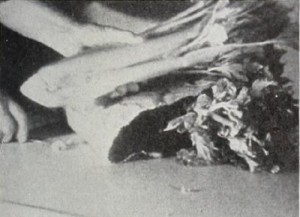
"White Hearts, filmed by William R. Hutchinson, whose Blossom Forth the Fruit placed in Ten Best last year, presents further evidence of Mr. Hutchinson's understanding of the treatment necessary in handling progressive developments in nature when it is used for educational subjects. This story of celery raising begins with shots of farmers preparing the rich black soil and concludes with sequences showing the produce, packaged, ready for shipment. One of the difficulties overcome was the achievement of variety of value in the scenes showing the white celery stalks in contrast with extremely dark earth. Human interest is introduced by including intimate shots of the workers. Logical progression, interesting compositional effects and a genuine feeling for texture and tactile values make this a fine study picture." Movie Makers, Dec. 1942, 508.
"Whither Flowing," depicts the nervous evils caused by parents in the thoughtless upbringing of children. The drama was compactly told, well acted and directed, and was marked by unusual photography." Photoplay, Nov. 1929, 67. "...Whither Flowing is a psychological study of hysteria.... Dr. Heise's Whither Flowing won second award in the dramatic division of the recent Photoplay Magazine contest...” Movie Makers, Feb. 1930, 104.
"Why Junior High School, by Irving Pollack, ACL, gives the answer to its own question with a freshness and vigor that mark it as an outstanding amateur achievement. Classroom activities, a difficult subject, were handled with fruitful appreciation of what goes into an interesting picture. The film is marked throughout with thoroughly satisfactory photography and there are some scenes which present highly effective compositions. The story, told with a carefully worked out plan, never is allowed to become dull or uninteresting. The directorial ability of Mr. Pollack is well shown in the manner of handling those who appear in the pictures, for no evidence of self consciousness can be seen. The audience gains the impression that the picture was made by some one who knew what he wanted and went directly after it." Movie Makers, Dec. 1934, 547.
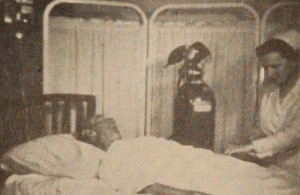
"Efforts of the American Cancer Society both to disseminate accurate information on the disease and to dispel erroneous conceptions form the theme of this unit production by the Amateur Movie Society of Bergen County, in Hackensack, N. J. Based jointly on a case history of neglect and a situation illustrating some baseless fears of cancer, the film shows the many forms of service rendered by the A.C.S. through its local chapters. Handsomely mounted and capably photographed, the picture is a tribute to the technical skill of its director, William Messner, and the cameramen who assisted him. The commentary and music on the sound track ably support the visual message. A tendency towards confusion in the scripting prevents the picture from fulfilling completely the thesis implied in its title." Movie Makers, Dec. 1949, 472.
Total Pages: 14